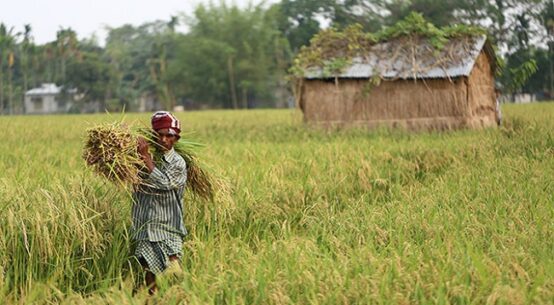
On Jan. 7, 2024, in a rural area of northwestern Bangladesh, a nilgai, the largest species of Asian antelope, crossed the border from India.
It never crossed back.
When villagers in Ranisankail subdistrict, Thakurgaon district, found out about the nilgai, also known as the blue bull, “they chased the animal and caught it,” villager Raihan Alam Chowdhury told Mongabay.
“When the news spread, excited villagers flocked to the site and slaughtered the blue bull. Later, the villagers shared the meat of the animal and consumed it,” he added.
Several weeks earlier, another nilgai narrowly escaped a similar fate. It, too, had meandered over from the Indian side of the border, on Nov. 23, 2023. Fortunately for this individual, though, it was spotted by Bangladesh border guards, who caught it with the help of locals.
“Later, the nilgai was handed over to the Forest Department,” said Nur Mohammad, a resident of Baliadangi, also in Thakurgaon district.
The presence of the two nilgais in Bangladesh paints a hopeful picture for the species Boselaphus tragocamelus, despite their mixed fates. The nilgai isn’t considered threatened on the IUCN Red List, given its abundant populations in India, Nepal and Pakistan (and introduced populations in the U.S. and Mexico). But in Bangladesh, the blue bull was declared extinct in the 1930s, nearly a century ago.
In a 2023 study, researchers in Bangladesh scoured media reports to identify 13 instances of nilgais entering the country’s northwest — mostly from India but also from Nepal — between 2018 and 2022. Historically, northwestern Bangladesh and the neighboring Indian state of West Bengal formed the easternmost range of the species, where the Brahmaputra and Ganga rivers served as a natural barrier to their eastward expansion. The animals once abounded in the sal forests and floodplains of what are today the districts of Dinajpur and Rangpur, both bounded by the two great rivers.
But it was the loss of these habitats, coupled with unchecked hunting, that drove the nilgais locally extinct, said Sarwar Alam, principal wildlife investigator with the Bangladesh office of the IUCN, the global wildlife conservation authority.
Now, however, their forays back into their historical habitats indicate that Bangladesh has room to once again host nilgais within its borders. The authors of the recent study suggest that local authorities should start thinking of reintroducing the species, which they describe as being easy to take care of, in the northwestern and central wet deciduous patches of the country.
Alam agreed, saying a protected area could be established in the northwestern districts near the border with India, where there are still large swaths of undisturbed natural landscape. Any reintroduction of the species would also have to be carried out in tandem with an educational campaign to prevent the nilgais being hunted and killed for food.
Abdur Rahman, a resident of Ranisankail, where villagers killed the nilgai in January, said many of the antelopes cross over each year, but only a handful of cases are reported; most of the time, locals catch and kill the animals for their meat.
Taslima Khatun, an officer with the Forest Department’s Thakurgaon range, said the department has only a rudimentary program in place to discourage the killing of nilgais.
“When we visit the bordering areas of the northwestern districts, we ask people not to kill the nilgais coming from India,” she told Mongabay.
Ishtiaq Uddin Ahmad, former chief conservator of forests and Bangladesh’s former country representative to the IUCN, said there needs to be undisturbed forest areas and some management measures to restore the nilgai population in Bangladesh.
“Nilgais could be reintroduced here in in-situ condition, but the antelope must be protected, ensuring its habitat, food, and water,” he said.
Rafiqul Islam is an environment and development journalist based in Dhaka, Bangladesh. He has been reporting on the environment, climate change, conservation, development and human rights.


